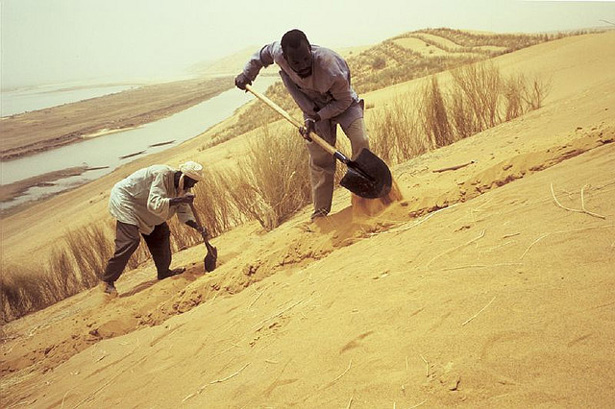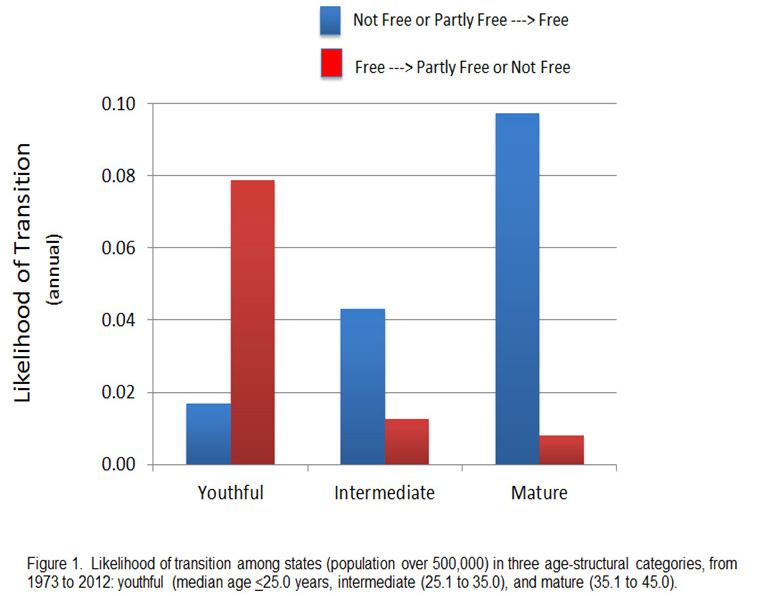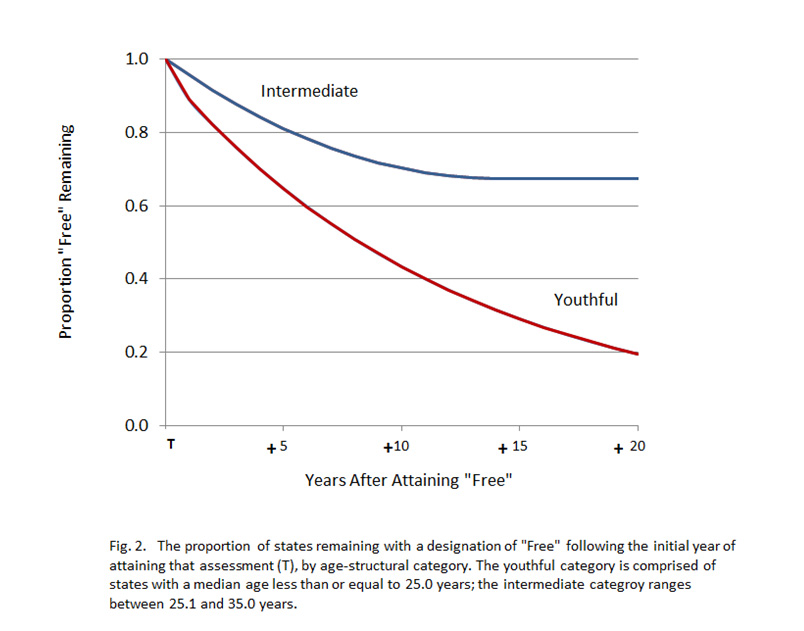-
Putting Mali Back Together Again: An Age-Structural Perspective
May 9, 2013 By Richard Cincotta
Once considered a model for Sahelian democracy, Mali’s liberal regime (assessed as “free” in Freedom House’s annual survey of democratic governance continuously from 2000 to 2011) virtually disintegrated in March 2012 when a group of junior army officers, frustrated by the central government’s half-hearted response to a rebellion in the state’s vast northern tier, found themselves – somewhat accidently – in control of the state.
With renewed elections in Mali slated for July and French troops containing Tuareg and Islamist insurgents, the Sahelian state appears to be on track to start again where it left off just over a year ago. However, several African and Western political commentators contend that putting Mali’s laudably democratic, yet habitually fragile and chronically ineffectual regime, back together again is simply a bad idea.
Whether right or wrong, their criticism highlights an unsettled question for Western interventionist powers: When coming to the aid of a fallen democratic regime, should an intervening Western power insist, at the end of the operation, on the restoration of high levels of democracy? Most Western diplomats would likely answer “yes, of course,” with little hesitation. However, as Graham Norwood’s Mali and Niger breakdown on New Security Beat mentions briefly, a recent analysis of the record of stability among liberal democracies with extraordinarily youthful populations – like Mali’s, where nearly half of the population is under the age of 16, and fertility remains more than six children per woman – suggests that under such circumstances, the state and its citizens might fare better with a bit less democracy.
Losing It
 Much has transpired since the coup d’état. In April 2012, the head of the military junta, Captain Amadou Sanogo, yielded to pressure from the Economic Community of West African States to affect a non-violent transfer of power to an interim government headed by Diaoncounde Traoré, the former president of Mali’s National Assembly. Nonetheless, conditions continued to deteriorate.
Much has transpired since the coup d’état. In April 2012, the head of the military junta, Captain Amadou Sanogo, yielded to pressure from the Economic Community of West African States to affect a non-violent transfer of power to an interim government headed by Diaoncounde Traoré, the former president of Mali’s National Assembly. Nonetheless, conditions continued to deteriorate.In May, supporters of the military coup broke into the presidential palace, assaulting and injuring Traoré. During the months that followed, the Malian Army suffered a string of humiliating defeats at the hands of the Tuareg-nationalist MNLA (Mouvement National pour la Libération d’Azwad) and two jihadist forces, Ansar Eddine and MUJAO (Le Mouvement pour l’Unicité et le Jihad en Afrique de l’Ouest). Fearful of state collapse and eager to halt violence being perpetrated on civilians in Mali’s north, in January 2013 France inserted a 7,000-strong force of soldiers.
So far, the military intervention appears successful. French and Chadian forces have halted the rebels’ southward advance, the insurgency has fragmented into skirmishes between jihadists and the MNLA, and the U.N. Security Council is preparing to authorize a peacekeeping mission.
At the urging of France and other Western backers of the intervention, Mali’s interim regime seems set to start up where it left off before the coup. Some African critics argue, however, that Malian democracy was shallow, dysfunctional, and fragile, and that it had made little progress on resolving the society’s deep inequalities and insecurities that emanate from the north. And, some contend, that the country’s citizens might be better off in the long run with less consensus politics, tougher social reforms, and tighter security.
My research suggests that this critique may be on point. Since the early 1970s, half of all youthful liberal democracies – states, like pre-coup Mali, with a regime assessed as “free” by Freedom House and a population with a median age younger than 25 years – have been incapable of holding this rating for a decade, and only one in five has held it for two decades. Mali, for all the praise lumped upon it, was (according to this model) an average performer.
Young and Unstable
 Since 1972, the year that Freedom House published its first annual global assessment of political rights and civil liberties, youthful states with high levels of democracy have been exceptionally unstable. For that 40-year period, their year-to-year risk of dropping out of the “free” category has been about six times higher than states with more mature age structures (see Figure 1). And the “decay rate” of youthful liberal regimes, which draws on Freedom House assessments from 1972 to 1992, has been steep when compared to intermediate-aged liberal regimes (Figure 2).
Since 1972, the year that Freedom House published its first annual global assessment of political rights and civil liberties, youthful states with high levels of democracy have been exceptionally unstable. For that 40-year period, their year-to-year risk of dropping out of the “free” category has been about six times higher than states with more mature age structures (see Figure 1). And the “decay rate” of youthful liberal regimes, which draws on Freedom House assessments from 1972 to 1992, has been steep when compared to intermediate-aged liberal regimes (Figure 2).The consequences to the populace of these “youthful democratic dropouts” have often been severe. Within five years of losing Freedom House’s “free” assessment, about half of these dropout states were being ruled by autocratic regimes (assessed as “not free”) or had hit the lower rungs of partial democracy (low scores in the “partly free” category).
Realistically, neither the criticisms of journalists nor the theories of political demographers are likely to have much bearing on decisions to remake or modify Mali’s regime. Nonetheless, it might be wise for those involved to understand the historical odds of obtaining and maintaining very high levels of democracy among states that have experienced Mali’s youthful demographic conditions. For the period that data is available, those odds have been consistently low.
Richard Cincotta is demographer-in-residence at the Stimson Center and a consultant on political demography for the Wilson Center’s Environmental Change and Security Project.
Sources: Freedom House, Jeune Afrique, The National Interest, Think Africa Press, UN Population Division.
Photo Credit: Fixation of dunes in Mali, courtesy of the UN World Food Program. Charts: Richard Cincotta.
Topics: Africa, aging, conflict, democracy and governance, demography, development, featured, foreign policy, Mali, population, security, youth
 A Publication of the Stimson Center.
A Publication of the Stimson Center.





